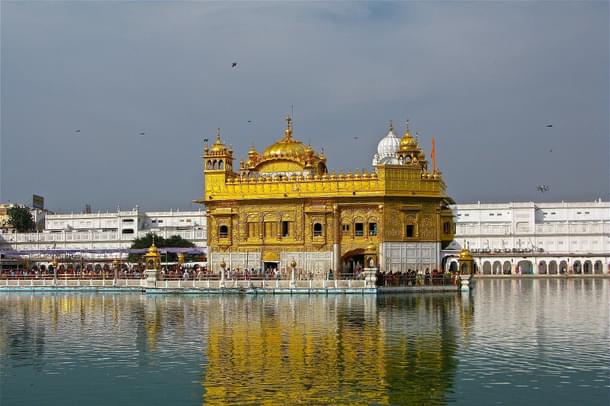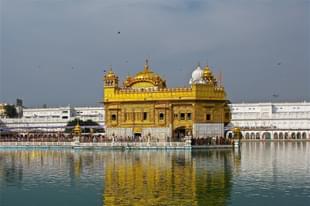Culture
Harmonium Ban In Golden Temple Puts SGPC's Priorities Into Question
Rohit Pathania
May 29, 2022, 02:56 PM | Updated 03:59 PM IST
Save & read from anywhere!
Bookmark stories for easy access on any device or the Swarajya app.


The Shiromani Gurdwara Parbandhak Committee (SGPC) has been pressed recently by the Jathedar of the Akal Takht, Giani Harpreet Singh, to stop permitting the use of harmoniums inside the precinct of Harmandir Sahib (the Golden Temple).
The logic provided by the Jathedar is that Guru Nanak Dev ji never used the harmonium and instead there was a string instrument player always accompanying him.
Mardana, who accompanied Guru Nanak Dev ji for a significant part of his life, has always been shown as playing a version of the rabab, a stringed instrument that gets plucked or played like the sarangi.
Among those who retain the Sikh musical tradition, very few can still play the instrument today. Instead, the harmonium has become the choice instrument.
As per news reports, preventing harmonium use will not be easy, since out of all the singers, only five can use string instruments and perform without the harmonium.
Given that each day 15 ragi jathas perform in the Darbar Sahib precincts, the challenge posed is enormous. This has received significant media attention, and a divide has arisen within the Sikh community, with some raising the issue of practical difficulty posed by this request.
What is curious, however, is the question of whether the Indian harmonium is truly a European invention.
As per the Government of India’s site 'Indian Culture', the Indian harmonium was a significant improvement on the European design, undertaken in 1875 by Dwarkanath Ghose, who designed his version of the Indian hand-pumped harmonium in Calcutta (now Kolkata).
The changes Ghose brought to the European version allowed its operation by hand in a seated position and made it more durable, less expensive to build, and easier to maintain and repair, among other benefits.
Given this fact, the claim that the harmonium is a British introduction may not hold water if scrutinised through the historical lens.
Why Ignore Women If One Is To Go By History?
If the historical precedent is to be taken seriously, one could question why women are not allowed to sing the shabad kirtan and gurbani inside the Darbar Sahib? This is one issue the SGPC seems uninterested in solving.
As an Indian Express report dated November 2019 pointed out, even after the SGPC came into existence in 1920, this discriminatory practice attributed to the pre-SGPC mahant-era has continued. For that matter, even today, women are not allowed to simply sit behind Singh ragis (men kirtan singers) at Darbar Sahib.
What makes it perhaps even more ironic, as some who supported the 2019 resolution of the Punjab Legislative Assembly on the subject pointed out, is that the issue has been going on at least since 1940, when the SGPC’s own resolution had said that there was no reason to discriminate.
It is not that an attempt was not made in this direction. In 2005, under the presidency of Bibi Jagir Kaur of the SGPC, it was announced that women would be permitted to do kirtan and sukhasan seva at the Darbar Sahib.
Additionally, arrangements were being made for women’s sukhasan seva, over which there had been significant controversy just two years prior, wherein two United Kingdom-born Sikh women were prohibited from participating in the seva, followed within months by another incident of two other Sikh women from the diaspora being pushed out of the line of people awaiting the sukhasan procession.
What followed was a familiar script. There were vehement protests by the Damdami Taksal and the then Jathedar and his predecessors.
Bhai Ranjit Singh, the former Jathedar of Damdami Taksal, even vowed that ‘‘Panthic organizations would physically remove’’ Joginder Singh Vedanti from his position of Jathedar of the Akal Takht if these changes were made.
Ranjit Singh even insisted that "the decision to allow Sikh women to perform ‘kirtan’ from the sanctum sanctorum of Harmandar Sahib should be taken only after taking entire Sikh Panth into confidence."
Another former Jathedar of the Akal Takht insisted that there was no historical precedence of women performing kirtan from the Darbar Sahib.
All this eventually led to the move getting scrapped within a month, as even the Sant Samaj, a conglomerate of Sikh religious figures, had backed the Taksal on the issue.
Larger Trend Visible
Of late, the Akal Takht Jathedar and the SGPC have been engaged in raking up panthic issues that only end up creating outrage. Be it the issue of the release of ‘Sikh prisoners’ or the issue of carrying weapons, there has been no dearth of controversies that seek to portray some kind of insecurity being faced by the community at large.
The move to ban harmonium may be seen as yet another step in this direction. In the past two years, the SGPC has already faced a lot of heat over the case of the missing saroops of the Sri Guru Granth Sahib ji in Punjab.
However, as the SGPC’s critics have stated, the SGPC is not interested in addressing the issues of Sikhs around the world and is instead using its influence and energy to propagate its supremacy without doing anything on the ground.
As Baba Sarabjot Singh Bedi, the head of a faction of Sant Samaj, had told the media, with apparent reference to the Shiromani Akali Dal (Badal)’s control on the SGPC, "...They (SAD) ruled Punjab for 15 years and never remembered Panth. After decimation (in assembly elections), they have remembered the Panth and the Sikh issues."
Rohit Pathania works in the space of renewable energy and environment. Other interests include politics and the economy.




